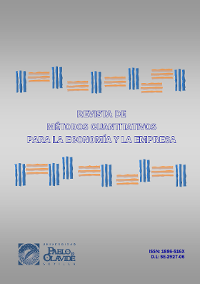Una combinación de un algoritmo voraz con algoritmos genéticos para optimizar la producción de cartón ondulado
DOI:
https://doi.org/10.46661/revmetodoscuanteconempresa.2130Palabras clave:
Industria cartonera, cajas de cartón, algoritmos genéticos, SPP-CP, corrugator manufacturing, cardboard boxes, genetic algorithmsResumen
En este trabajo se propone la utilización de un algoritmo genético para la optimización del corte continuo de planchas de cartón, un problema habitual en la industria cartonera, donde la minimización de mermas de materia prima y el cumplimiento de los plazos de fabricación son dos objetivos prioritarios de la planificación de la producción.
Las soluciones aportadas por un algoritmo voraz se utilizan como semillas para el algoritmo genético. Se utiliza el operador de recombinación de cruce en un punto.
Descargas
Citas
Álvarez-Valdés, R.; Parreño F.; Tamarit J.M. “Reactive GRASP for the strip-packing problem”, Computers & Operations Research, vol.35, nº4. pp.1065–1083, 2008.
Amadeh, A.; Hellström, D. “The problem of corrugator sequencing and its impact on packaging processes”, 2008: http://www.lu.se/o.o.i.s?id=12683&postid=1300725
Bortfeldt, A. “A genetic algorithm for the two-dimensional strip packing problem with rectangular pieces”, European Journal of Operational Research, vol.172, nº4, pp.814–837, 2006.
De la Fuente García, D.; Gómez Gómez, A. “Resolución de problemas de corte de piezas rectangulares mediante algoritmos genéticos”, En: La gestión de la diversidad: XIII Congreso Nacional, IX Congreso Hispano-Francés, Logroño (La Rioja), 16-18 junio 1999 (coord. Juan Carlos Ayala Calvo), vol.1, 1999, pp.1299–1306, 1999.
Holland, J. H. “Adaptation in Natural and Articial Systems”, Ann Arbor: The University of Michigan Press, 1975.
Jaramillo, J.D.; Correa, F.J. “Programación lineal y algoritmos genéticos para la solución del problema de corte”, enviado a revisión a la Revista Colombiana de Computación, 2008: http://ingenieria-matematica.eafit.edu.co/biblioteca/practicas_investigativas/prac_inv_programacion_lineal_ag_corte.pdf
Jaramillo, J.D.; Correa, F.J.; Jaramillo, R. “Desarrollo de un método basado en algoritmos genéticos y programación lineal para la solución de un problema de corte unidimensional”, enviado a revisión a la Revista de Ingeniería de la Universidad Eafit, 2009: http://serverlab.unab.edu.co:8080/wikimedia/memorias/shortpapers/161.pdf
Kureichik V.M.; Miagkikh V.V.; Topchy A.P. “Genetic Algorithm for Solution of the Traveling Salesman Problem with New Features against Premature Convergence”, TSURE Journal of Engineering, nº3, 1997.
Lodi, A.; Martello, S.; Monaci, M. “Two-dimensional packing problems: A survey”, European Journal of Operational Research, vol.141, nº2, pp.241–252, 2002.
Martello, S.; Monaci, M.; Vigo, D. “An exact approach to the strip packing problem”, Technical Paper OR/00/18, Dipartamento di Elettronica, Informatica e Sistemica,Università di Bologna, 2000.
Rinaldi, F.; Franz, A. “A two-dimensional strip cutting problem with sequencing constraint”, European Journal of Operational Research, vol.183, nº3, pp.1371–1384, 2007.
Velásquez, G.A.; Bellini, G.; Paternina-Arboleda, C. “A multi-objective approach based on soft computing techniques for production scheduling in corrugator manufacturing plants”, Ingeniería y Desarrollo 2007, (enero-junio): http://redalyc.uaemex.mx/redalyc/src/inicio/ArtPdfRed.jsp?iCve=85202106
Vuk, D. “An Approach to the Guillotine Strip Packing Problem”, 2008: http://www.ceciis.foi.hr/app/index.php/ceciis/2008/paper/view/97/69
Descargas
Publicado
Cómo citar
Número
Sección
Licencia
Derechos de autor 2009 Revista de Métodos Cuantitativos para la Economía y la Empresa

Esta obra está bajo una licencia internacional Creative Commons Atribución-CompartirIgual 4.0.
El envío de un manuscrito a la Revista supone que el trabajo no ha sido publicado anteriormente (excepto en la forma de un abstract o como parte de una tesis), que no está bajo consideración para su publicación en ninguna otra revista o editorial y que, en caso de aceptación, los autores están conforme con la transferencia automática del copyright a la Revista para su publicación y difusión. Los autores retendrán los derechos de autor para usar y compartir su artículo con un uso personal, institucional o con fines docentes; igualmente retiene los derechos de patente, de marca registrada (en caso de que sean aplicables) o derechos morales de autor (incluyendo los datos de investigación).
Los artículos publicados en la Revista están sujetos a la licencia Creative Commons CC-BY-SA de tipo Reconocimiento-CompartirIgual. Se permite el uso comercial de la obra, reconociendo su autoría, y de las posibles obras derivadas, la distribución de las cuales se debe hacer con una licencia igual a la que regula la obra original.
Hasta el volumen 21 se ha estado empleando la versión de licencia CC-BY-SA 3.0 ES y se ha comenzado a usar la versión CC-BY-SA 4.0 desde el volumen 22.










